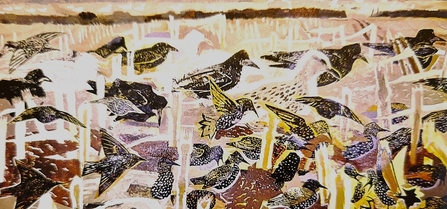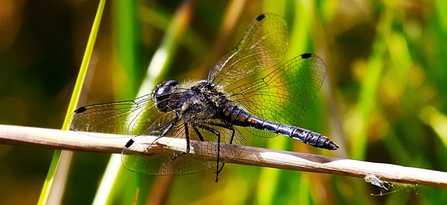Following the plough
Gulls, mainly black headed and lesser black back gulls, are returning to the county and flocks can be seen feeding on recently ploughed fields. This suggests that, despite their intensive cultivation and the use of molluscicides, herbicides and pesticides, somehow some invertebrate life manages to exist.
Corvids, especially rooks and jackdaws, also seem to find things to eat in stubble.
Wild Update - September 2024

Kim Atkinson - 'Rook and Starlings in stubble'
There’s something of an Egyptian hieroglyph about Kim Atkinson’s ‘Rooks and starlings in stubble’ artwork isn’t there?
Kim Atkinson (SWLA) is an artist who lives on the Llyn peninsula in North Wales. Her style has changed and evolved over time from representational to abstract: SWLA – The Society of Wildlife Artists .
Rain means fungus
Following the recent heavy rain, we can expect to see fungi sprouting up in the coming days. Already I’ve seen parasols and a large and very splendid beefsteak fungus growing on an oak tree.
This fungus does indeed look like a steak from above.

Beafsteak minus the beef - NB
The underside of the fungus is pale initially but soon turns dark and exudes ‘blood’ as the fungus ages.
This species is said to be common and widespread though I don’t come across it that often myself. It is edible though I hope no forager walks off with this fine specimen.
Two white tails
It transpires that two white-tailed eagles from the Isle of Wight
Re-Introduction Project have overflown the county in the last week or so, both wearing trackers put on them by the Roy Dennis Wildlife Foundation.
The first (G644) flew over Carsington’s dam wall on 16th. This was a juvenile reared in 2023.
The second (G813) was photographed by a glider pilot over Stoney Middleton on or about 20th.
Black and darting
In this county, we have a few acid bog-loving dragonflies and damselflies including the common hawker, Aeshna juncea and the lovely little black darter, Sympetrum danae.
Both can be found well into the autumn.
The photo below of a male was taken by Kieron Huston at Ramsley Reservoir recently. Apart from its small size, note the very black pterostigma marks near the end of the wings and the black body with some yellow markings. A fine insect for sure.

Male black darter. Ramsley Reservoir. Kieron Huston
Mimicry
The ability of some birds to mimic both the songs of other species and human and mechanical sounds is extraordinary.
On YouTube you’ll find many videos of tame/pet starlings mimicking whatever they hear inside the house and they are worth a listen.
However, I prefer to hear wild birds mimic other species. I remember reading about a nature writer in London one winter hearing a starling on his chimney pot mimic a golden oriole which told him that it had come from somewhere in Europe where these exotic-looking orioles breed.
Sadly we rarely get starlings in the garden and never on the roof or chimneys chortling away to themselves on a winter’s day, something that was commonplace thirty years ago.
More on other forms of mimicry next time perhaps.
